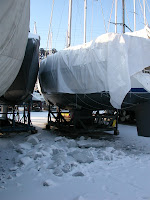In CROWLEY'S TIP #9, we talked about the causes of corrosion and said sacrificial anodes are one tool that will help prevent it. This is only one of many preventative measures you can take. Below, we continue the discussion on how to protect your investment against corrosion.
A Coat of PaintThe first line of defense against corrosion is the protective paint covering on your engine and components. It is important that this finish is maintained, as it protects the aluminum from exposure to corrosion. Always repair paint scratches and chips promptly and never use a wire brush to sand an engine surface. This will embed small steel particles from the brush into the aluminum, creating destructive “galvanic cavities” for corrosion to take place.
Continuity devicesWhile they all outwit corrosion, paint, sacrificial anodes and continuity devices all work differently. Paint blocks corrosion while sacrificial anodes absorb it. By contrast, continuity devices maintain contact between all vulnerable components on an engine. This circuit is then connected to a zinc so that this sacrificial anode takes the hit from any electrical activity going on. There are several types of continuity devices to accommodate your type of engine. Whatever anode the circuit is connected to must be periodically inspected and replaced when corroded 50% or more.
Mercathode systemMerCruiser offers the MerCathode system (available at Crowley’s for $95.45 plus tax), which provides automatic protection against galvanic corrosion for all makes of outboards and stern drives. It is a solid-state device that operates off a boat's 12-volt battery and provides protection by impressing a reverse blocking current that stops the destructive flow of galvanic currents. The Mercathode system has two parts: the controller and the anode.
The controller and anode are connected by a protective current that flows from the battery through the controller to the anode and finally into the water. The controller is located in the boat and it's usually mounted on the engine. It sends a signal to the anode which develops a protective field around the sterndrive unit to protect it against galvanic corrosion. It should be wired directly to the battery’s positive terminal with the included in-line fuse. The Mercathode must stay powered up even if the battery switch is turned off.
The anode is coated with platinum so it won’t corrode away. The reference electrode senses the corrosion potential in the water and then regulates the controller for optimum corrosion protection. The system then compensates for water temperature, movement and salt content, even for changes in the condition of the paint on the drive unit. The current required by the system is so small you can operate up to several weeks before having to charge your battery. Merchatode automatically turns off when the boat is removed from the water.
The Mercathode system does not protect internal surfaces which pocket moisture and dirt. Therefore, remember to flush the drive with fresh water before storage. Like sacrificial anodes, the mercathode anode and reference anode should never be painted. Never clean the anode, this could scratch the platinum coating and cause backing to corrode. The mercathode system should be checked once/year to ensure it’s providing adequate protection. Whenever a boat is using stainless steel props or other stainless steel components below the waterline and tied into continuity circuit, a mercathode system or anti-corrosion anode kit should be installed.
Keep reading for future installments of how to prevent marine corrosion.
 The odds of your boat being struck by lightning are about 1.2 in 1,000 but when it comes to lightning protection, you’re on your own. No federal or state laws require manufacturers to install a grounding system. While no one has found a foolproof answer, there are some easy preventative measures to take so you don’t end up like this Chicago sailboat.
The odds of your boat being struck by lightning are about 1.2 in 1,000 but when it comes to lightning protection, you’re on your own. No federal or state laws require manufacturers to install a grounding system. While no one has found a foolproof answer, there are some easy preventative measures to take so you don’t end up like this Chicago sailboat.











